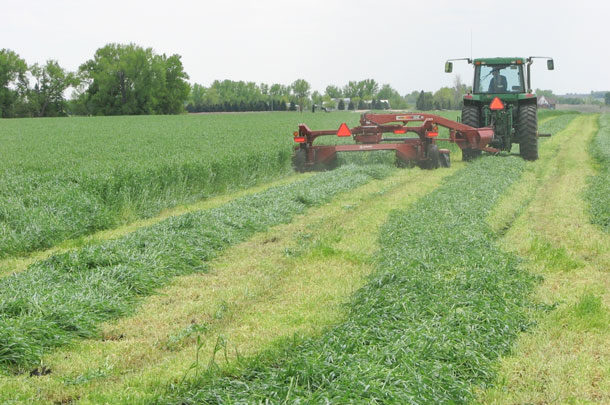We can, however, grow crops such as winter rye or winter wheat for forage and then follow with a grain crop such as corn or soybeans. This may work well for organic production since most organic farmers plant their corn and soybeans later to avoid early spring weed flushes. This last year, we tried this method on 40 organic acres at the University of Minnesota West Central Research and Outreach Center (WCROC).
In the fall of 2015, we planted 20 acres of winter wheat and 20 acres of winter rye. The mild winter allowed both crops to survive without any winter kill. We harvested 10.8 tons per acre from the winter rye (as seen in the picture) on May 18 and 8.7 tons per acre on the winter wheat on May 26. Both crops were put up as high-moisture haylage and bagged with an Ag Bag silage bagger. We then planted one-half of each winter crop to a 79-day corn and early soybean on June 2. This method allowed for good soybean yields this year. The yield was over 40 bushels per acre. We have not yet harvested the corn, but expect at least 120 bushels per acre.
In order to determine if this system is feasible, value must be placed on forage and grain. As a rule of thumb, dry hay is worth $1 per ton per one RFQ (relative forage quality) value. The RFQ of the winter rye was 157. If we use $60 a ton ($155 per ton at 15 percent moisture) for the value of forage, winter rye value of $650 per acre and soybeans at a value of $680 ($17 per bushel), then the total for this system with soybeans is $1,320 per acre. If organic corn yields 120 bushels per acre with the going market rate of $7 per bushel, the value of corn is $840. This system with corn yields $1,490 per acre.
We probably did not lose any yield with the soybeans using this method, but we most likely will with corn. If we lose 40 bushels per acre, then the estimated value of lost corn production is $280 per acre, but if we lose 160 bushels per acre, lost corn production comes in at approximately $1,120 dollars per acre.
Using winter wheat and winter rye for a forage crop before corn or soybean production worked out well for us this year, but it may not work every year due to weather and workload. Wet weather can delay harvesting of the winter cereals and have a negative impact on forage quality. Wet weather can also affect the planting date of corn, which is more critical than soybeans.
We also had challenges preparing a good seedbed due in part to cloddy finished fields. As a result of the poor seedbed, we had a more uneven corn stand than other fields. This meant we had to use a rotary hoe instead of harrow for the first weed control pass. The first rotary hoe pass was not as effective because of the clods.
Winter rye may have an allopathic effect early on corn. The poor seedbed could have also caused lower early vigor. The allopathic effect from the rye may have helped soybean weed control as the soybeans planted on the rye field had less weeds. Weeds are often yield-limiting in an organic system. More research is needed on the interaction of the allopathic effect and weed control on corn and soybean yields in an organic system.
This system may not work as well for producers who want to put the forage up as dry hay because of the time needed due to dry time. Usually, we cut the forage crop and harvest and bag it the next day. In the case of the winter rye, we needed two days of drying. Cooler spring weather may affect the drying and quality of the crop. We chopped both the winter wheat and winter rye so we could quickly plant the corn and soybeans.
When looking at the feasibility of a cropping system such as this, multiple years of data needs to be considered when determining if this is a viable option for producers. ![]()
Curt Reese is an agronomy and soil scientist.
The University of Minnesota West Central Research and Outreach Center (WCROC) provides research-based innovative solutions to farmers, producers and citizens. Its areas of research include agronomy, dairy, horticulture, renewable energy and swine. The WCROC is located in Morris, Minnesota. Learn more at the WCROC website.
—Excerpts from the WCROC October 2016 newsletter.
PHOTO: Photo courtesy of WCROC.










